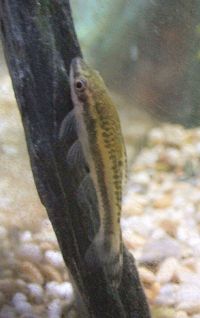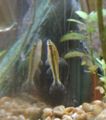Oto (Otocinclus vittatus)
From The Aquarium Wiki
Otocinclus vittatus
38 Litres (10 US G.)
2.5-3.3cm (1-1.3 ")
Freshwater
5.5 - 7.5
20.6-26.1°C (69 -79 °F)
6-10 °d
1:2 M:F
2-4 years
Family
Loricariidae
Contents
Additional names
Sexing[edit]
- These fish are difficult to visually sex. Mature females are slightly bigger than males.
Tank compatibility[edit]
- An excellent peaceful community fish. There is, however, records of suckermouth fish sucking on slime coats of slow moving large bodied fish such as Angelfish and Discus. Therefore, they are best kept with active but non-aggressive tank mates. Keep all Otos in groups of 3-4 or more.
Diet[edit]
- Otos will mainly graze on some soft algaes, primarily diatoms, and blanched vegetables such as Zucchini (Courgette), Carrot, Potato and Cucumber. They may also accept some algae wafers, but it can take some time to wean them onto these. They will not eat hair algae or green spot algae.
Feeding regime[edit]
- They graze on algae virtually all the time, so ensure there is enough algae in the tank. If not, supplement with the foods mentioned above.
Environment specifics[edit]
- A planted aquarium is a must. Ensure you get them in decent numbers at least 3. They are a nervous fish if not kept in groups and have been know to die from stress if not kept as so. As this small fish eats whilst resting on a surface, they are easy targets for larger fish in the wild. Prefers to rest on vertical surfaces such as the glass or slate, will also rest on broad leaves.
Behaviour[edit]
- They tend to rest on any object, including the front glass so you'll get plenty of views of their underside. They will often rest in one spot for hours at a time and will dart about and crash into things if startled.
Identification[edit]
- The O.vittatus is identifiable from the other similar Otocinclus species in that it does have a thick bold horizontal line running down it's lateral line from nose to the base of the caudal tail, and, unlike most other similar Otocinclus, there is a thick white line running above this line, again from the nose to the base of the caudal fin. The base of the caudal should not have a large spot like the Otocinclus macrospilus, the black lateral line should run into the caudal without becoming thicker or blurred.
Pictures[edit]
External links[edit]
- Fishbase (Mirrors:
 )
)

